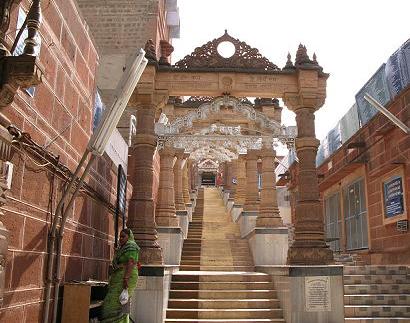
Welcome |
|
|
|
|
|
|
|
|
|
|
|
|
|
|
|
|
|
|
|
|
|
|
|
|
|
|
|
|
|
|
|
|
|
|
|
|
|
|
|
|
|
|
|
|
|
|
|
|
|
|
|
|
|
|
|
|
|
|
|
|
Introduction
of Osian |
|
Osian, an ancient small temple
town in the Thar Desert, is located about 65 kms, north west of
Jodhpur. Osian is a great centre of Brahmanical and Jain
religions and contains the largest group of the Hindu and Jain
temples in Rajasthan. These temples belongs to the two periods,
namely 8th century represented by nearly 12 temples and 12th
century represented by 6 temples.
History of Osian
In the medieval period, Osian was a large and bustling town and caravans
from Arabia, Persia, Afghanistan and central Asia arrived here for trade. Osian was also the capital of the Gurjara Pratihara dynasty from the 8th
to 12th century. Osian was an important centre of pilgrimage between the
8th and 9th centuries. This can be known from the surviving Hindu temples
|
 |
|
of the
Vaishnava, Surya (Sun) and Shakti (mother goddess) sects. The
Brahminical influence was very strong in Osian during that period and
later, Jainism also flourished in the place through the Gurjara Pratihara
dynasty. But still, various Hindu devotees visit the Osian temple
dedicated to the goddess Sachiyamata. In ancient times, Osian was known as
Ukeshpur.
|
|
|
|
Tourist
Attraction in Osian |
|
The major tourist attraction in Osian are the 15 Brahmanical Hindu temples
and shrines and Jain temples. These temples were built during the rule of
the Gurjara Pratihara dynasty between 8th and the 12th century. These
temples are very small and beautifully built and richly sculpted. The main
feature of these temples is is that no two temples are alike in any manner
and each temple has its own unique design, planning and layout. The stone
from which these temples were built was extracted from local quarries, and
has managed to withstand the vagaries of nature for various centuries.
The main temple of Osian is set on a terrace whose walls are decorated
with mouldings and miniatures. The temple is called a panchavatan temple
as the central shrine is surrounded by four small shrines. The walls of
the temple have central projections with carved panels and above these
rise the curved towers topped by an amalaka and pot finial. The doorways
are usually decorated with river goddesses, serpents and scrollwork. A
group of 11 temples belong to the 8th-9th centuries and lies within and on
the outskirts of the Osian village. The other group of temples that belong
to the 11th and 12th centuries are located on a hill overlooking the
village. The temples are grouped in several groups like the North group,
West group and South group. The South group includes three Harihara Hindu
temples. The architecture of the interiors of this temple is very
impressive and is known for the beautifully decorated walls. The West
group contains a mixture of Hindu (Surya, Vishnu and Pippala Devi)
temples, an 8th century tank and an 11th century Jain (Mahavira) temple.
The South group includes the Surya temple (early 8th century) and the
Sachiya Mata Temple (11th - 12th century). The Jain Mahavira temple is
unique among the various Osian temples, with the vaulted design of its
hall-ceiling. The main Sachiya Mata temple appears to be made in 1178 AD
and has a shikhar clustered by two rows of turrets, an ambulatory and a
large assembly hall with an elaborate ceiling. The Sun temple is the
oldest temple of the group. Its doorway is regarded as one of the finest
temple doorways in India.
|
|
|
|
|
|
|